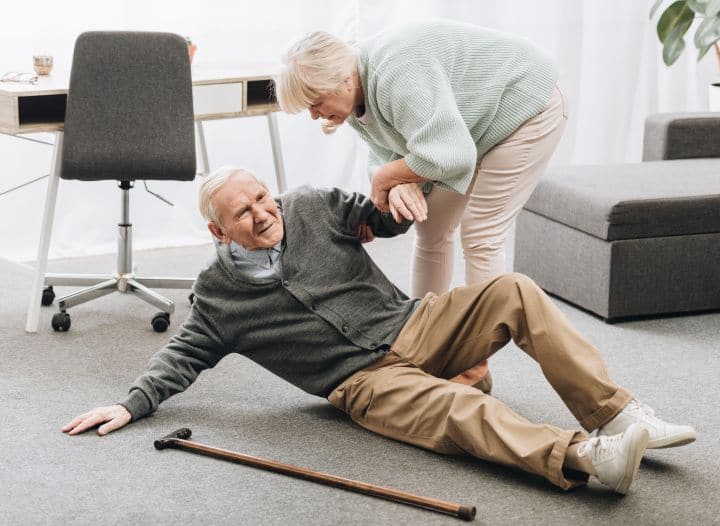
A broken collarbone is a common injury among the elderly population. It can be caused by a fall or a direct blow to the shoulder. The collarbone, also known as the clavicle, is a bone that connects the shoulder blade to the breastbone. When it is broken, it can cause pain, swelling, and difficulty moving the arm.
Treatment for a broken collarbone in the elderly depends on the severity of the injury. In some cases, a simple sling or brace may be enough to immobilize the shoulder and allow the bone to heal. However, in more severe cases, surgery may be necessary to realign the bone and hold it in place with pins or plates. Recovery time can vary, but most patients can return to their normal activities within a few months. It is important for the elderly to receive proper treatment for a broken collarbone in order to prevent further complications and ensure a full recovery.
Understanding Collarbone Fractures
Collarbone fractures, also known as clavicle fractures, are a common injury among the elderly population. The collarbone is a long bone that connects the shoulder blade to the breastbone, and it is susceptible to fractures due to falls, sports injuries, and vehicular accidents.
There are three types of collarbone fractures:
- Type I: This is the most common type of fracture, where the bone is broken in the middle of the collarbone.
- Type II: This type of fracture occurs near the shoulder blade.
- Type III: This is the least common type of fracture, where the bone is broken near the breastbone.
The fracture site can also vary, but most commonly, the middle third of the collarbone is affected.
A broken collarbone can cause severe pain, swelling, and bruising. The individual may also experience difficulty moving their arm or shoulder. It is essential to seek medical attention immediately after the injury to prevent further damage.
Treatment for collarbone fractures depends on the severity of the injury. In many cases, a simple arm sling or brace is sufficient to immobilize the shoulder and allow the bone to heal naturally. However, surgery may be required for more severe fractures.
In conclusion, collarbone fractures are a common injury among the elderly population. Understanding the type of fracture and the fracture site is essential in determining the appropriate treatment plan. Seeking medical attention immediately after the injury is crucial for a successful recovery.
Causes of Broken Collarbone in the Elderly
A broken collarbone, also known as a clavicle fracture, is a common injury among the elderly. It can be caused by a variety of factors, including motor vehicle accidents, outstretched arm, contact sports, direct blow, car accidents, greater heights, and sports injuries.
Motor vehicle accidents can result in a broken collarbone when an elderly person is involved in a collision. The force of the impact can cause the collarbone to fracture. Similarly, a direct blow to the shoulder, such as from a fall, can also cause a fracture.
Outstretched arm injuries are another common cause of broken collarbones in the elderly. When a person tries to break their fall with an outstretched arm, the force can be transmitted to the collarbone, causing it to break.
Contact sports, such as football or rugby, can also cause collarbone fractures in the elderly. These sports involve physical contact, and a direct hit to the shoulder can result in a fracture.
Car accidents can also cause collarbone fractures in the elderly. The force of the impact can cause the collarbone to break, especially if the elderly person is not wearing a seatbelt.
Greater heights can also be a factor in collarbone fractures. Falls from a height can result in a direct blow to the shoulder, causing the collarbone to fracture.
Sports injuries, such as skiing or snowboarding, can also cause collarbone fractures in the elderly. These sports involve high speeds and the risk of falls, which can result in a fracture.
Overall, there are many causes of collarbone fractures in the elderly. It is important to take precautions to prevent these injuries, such as wearing seatbelts while driving and avoiding high-risk activities.

Symptoms and Diagnosis
A broken collarbone, also known as a clavicle fracture, is a common injury in the elderly population. The fracture can occur due to a fall on an outstretched arm or a direct blow to the shoulder. Symptoms of a broken collarbone include pain, swelling, and bruising around the shoulder area. The patient may also experience difficulty moving their arm or shoulder.
During the physical examination, the doctor will inspect the shoulder area for any visible signs of injury, such as swelling or deformity. They may also gently press on the collarbone to check for tenderness or pain. In some cases, the doctor may order imaging tests to confirm the diagnosis.
X-ray of the clavicle is the most commonly used imaging test for diagnosing a broken collarbone. The test can show the location and severity of the fracture. In some cases, a computerized tomography (CT) scan may be ordered to get a more detailed view of the fracture.
Overall, early diagnosis and treatment are essential for a successful recovery from a broken collarbone in the elderly.
Treatment Options
Treatment for a broken collarbone in elderly patients depends on the severity of the injury and the patient’s overall health. Treatment options can include:
Non-Surgical Treatment
Non-surgical treatment options for a broken collarbone may include immobilization of the affected area, pain medication, and physical therapy. A physical therapist can help the patient perform exercises that can help with the healing process and restore range of motion. Pain medication can help manage any discomfort the patient may experience.
Surgical Treatment
If the collarbone is severely displaced, surgery may be required. Internal fixation, such as plates or screws, may be used to hold the bone in place. Open reduction may also be necessary to reposition the bone.
Early Physical Therapy
Early physical therapy can help patients regain strength and range of motion in the affected area. This can help prevent long-term complications and improve overall quality of life.
Overall, treatment for a broken collarbone in the elderly should be tailored to the individual patient’s needs and circumstances. A healthcare provider can help determine the best course of action.
Specific Risks for Elderly Patients
Elderly patients with a broken collarbone face greater risks than younger patients. The mortality rate for elderly individuals with a broken collarbone is higher than that of younger patients, and complications can arise more frequently.
One of the main risks for elderly patients is delayed healing. As people age, their bones become more brittle and less able to regenerate. This can lead to slower healing times and a higher risk of non-union, where the bone fails to heal properly.
Another risk is the development of osteoporosis, which is a condition where the bones become weak and brittle. This can increase the risk of a broken collarbone, as well as other types of fractures.
Elderly patients are also at a greater risk of developing complications such as pneumonia or blood clots. This is due to reduced mobility, which can lead to a decrease in lung function and circulation.
To minimize these risks, it is important for elderly patients to receive prompt and appropriate treatment for their broken collarbone. This may include immobilization with a sling or brace, pain management, and physical therapy to help improve mobility and prevent complications.
Overall, it is important to recognize the specific risks that elderly patients face when treating a broken collarbone. By taking these risks into account and providing appropriate care, healthcare providers can help improve outcomes for this vulnerable population.
Recovery and Rehabilitation

After a broken collarbone in the elderly, recovery and rehabilitation are crucial to restore normal shoulder function. The length of the recovery period can vary depending on the severity of the injury, but most patients can expect to return to normal activities within 6-8 weeks.
During the recovery period, the patient will likely need to wear a sling to immobilize the shoulder and allow for proper healing. The sling should be worn as directed by the physician, and the patient should avoid any activities that may disrupt the healing process.
As the patient progresses in their recovery, they will begin rehabilitation exercises to improve muscle strength and motion of the shoulder. These exercises may include range of motion exercises, shoulder blade stabilization exercises, and strengthening exercises for the rotator cuff muscles.
It is important for the patient to work closely with a physical therapist to ensure proper technique and to prevent any further injury. The physical therapist will also develop an individualized rehabilitation plan that takes into account the patient’s age, overall health, and specific injury.
As the patient’s strength and motion improve, they can gradually return to normal daily activities. It is important to avoid any activities that may cause pain or discomfort, and to continue with the rehabilitation exercises as directed by the physical therapist.
In summary, recovery and rehabilitation after a broken collarbone in the elderly is a crucial step in restoring normal shoulder function. With proper care and guidance from a physician and physical therapist, most patients can expect to return to normal activities within a few weeks to a couple of months.
Complications and Challenges
Treatment for a broken collarbone in the elderly can be challenging due to various complications that can arise during the healing process. The severity of the complications depends on factors such as the type of break, the location of the fracture, and the injured area.
In severe cases, where bone fragments are displaced or the break is open, surgery may be required to realign the bone fragments and stabilize the collarbone. This can be a challenging procedure for elderly patients as it requires anesthesia and may involve larger incisions.
Immediate medical attention is crucial for elderly patients with broken collarbones, as delayed treatment can lead to complications such as non-union or malunion of the bone. Non-union refers to the failure of the bone to heal properly, while malunion refers to the healing of the bone in a misaligned position.
Elderly patients may also experience severe pain during the healing process, which can be managed with painkillers and other medications. However, pain management can be challenging in some cases, especially if the patient has other medical conditions that limit their ability to take certain medications.
Smaller incisions and minimally invasive techniques can be used to treat broken collarbones in the elderly, which can reduce the risk of complications and improve the recovery time. However, these techniques may not be suitable for all patients, especially those with more severe fractures or injuries.
The non-union rate for broken collarbones in the elderly is relatively high, which can lead to long-term complications such as chronic pain and limited mobility. Therefore, it is important for elderly patients to receive proper medical attention and follow-up care to ensure a successful recovery.
Role of Health Care Providers
When it comes to the treatment of a broken collarbone in the elderly, health care providers play a crucial role in ensuring proper care is given. They are responsible for diagnosing the injury and determining the best course of treatment based on the patient’s age, overall health, and the severity of the break.
Health care providers may include primary care physicians, emergency room doctors, and nurses. They are often the first point of contact for patients who have suffered a broken collarbone and can provide initial treatment such as pain management and immobilization of the affected area.
Orthopedic surgeons are also an important part of the treatment team. They specialize in the diagnosis and treatment of musculoskeletal injuries, including broken collarbones. They may be consulted to provide more advanced treatment options such as surgery or specialized rehabilitation programs.
It is important for health care providers to work together to ensure the best possible outcome for the patient. This may involve coordinating with physical therapists, occupational therapists, and other specialists to develop a comprehensive treatment plan that addresses the patient’s individual needs.
Overall, the role of health care providers in the treatment of a broken collarbone in the elderly is critical in ensuring proper diagnosis, treatment, and rehabilitation. By working together and utilizing their expertise, health care providers can help patients recover from their injury and regain their quality of life.
